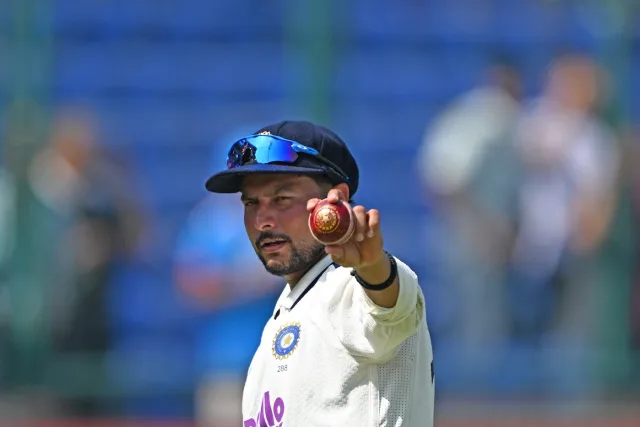Strategic Move: Why India Released Kuldeep Yadav Mid-Series Against Australia

Table Of Contents
The Indian team management requested to release Kuldeep Yadav from the ongoing T20I series in Australia to allow him to participate in the India A series against South Africa A at the BCCI Centre of Excellence in Bengaluru for the second four-day Test match starting on November 6. The announcement came shortly after India leveled the five-match T20I series at 1-1 with a convincing victory in the third match at Hobart.
This decision wasn't made impulsively. It reflects a calculated approach to player management, especially for a bowler who has become increasingly crucial to India's Test cricket ambitions. The timing of the release ensures that Kuldeep gets adequate preparation time while not significantly weakening India's T20I squad, which possesses considerable depth in the spin department.
Kuldeep's Performance in Australia
Before his release, Kuldeep Yadav featured in the first two T20I matches of the Australian series. The first match was abandoned due to rain and the second match resulted in a win for Australia, where he took two wickets. His performance in Melbourne, where he claimed 2/45, demonstrated his continued ability to pick up wickets even in the shorter format.
However, he was left out of the XI for the third T20I in Hobart and Washington Sundar took his spot. The omission from the third match already hinted at the team management's plans, as Washington Sundar's all-round abilities offered a different dimension that the team combination demanded for that particular match.
The rotation policy and the decision to rest Kuldeep from the final two T20Is against Australia reflects the team management's confidence in their spin bowling options. With Varun Chakaravarthy, Axar Patel, and Washington Sundar available, India possesses adequate spin depth to handle the remaining matches without compromising their competitive edge.
The Red-Ball Preparation Priority
The primary motivation behind Kuldeep's release centers on India's upcoming Test assignments. Kuldeep was the leading wicket-taker with 12 wickets in the two-match Test series against the West Indies last month as the 30-year-old returned to India's red-ball line-up after almost a year. This stellar performance cemented his position as a key player in India's Test bowling attack.
The West Indies series marked Kuldeep's successful comeback to Test cricket, and his performances there demonstrated why he's considered one of the most potent weapons in subcontinental conditions. Kuldeep finished as the highest wicket taker in India's 2-0 Test series win over the West Indies in October with 12 wickets from two matches at an average of 19.50, including his best figures of 5-82 coming in the second game in New Delhi.
The South Africa series presents a sterner examination of India's Test credentials. The Proteas, known for their competitive spirit and quality batting lineup, will pose challenges vastly different from those encountered against the West Indies. Adequate preparation becomes paramount, especially for a specialist bowler returning to the longest format after an extended absence.
The India A Assignment
Kuldeep's immediate destination is the India A camp in Bengaluru, where he joins an impressive roster of players preparing for international duty. The India A updated squad for the second four-day game includes Rishabh Pant as captain and wicketkeeper, KL Rahul, Dhruv Jurel, Sai Sudharsan as vice-captain, Devdutt Padikkal, Ruturaj Gaikwad, Harsh Dubey, Tanush Kotian, Manav Suthar, Khaleel Ahmed, Gurnoor Brar, Abhimanyu Easwaran, Prasidh Krishna, Mohammed Siraj, Akash Deep, and Kuldeep Yadav.
This squad composition reveals the strategic importance of the India A fixtures. With established players like Rishabh Pant, KL Rahul, Mohammed Siraj, and Prasidh Krishna included, it's clear that these matches serve as crucial preparation grounds for the main Test squad. The presence of these quality players ensures competitive match situations that will adequately prepare Kuldeep for the challenges ahead.
The India A versus South Africa A series has already witnessed intense competition. India A won the first four-day match, with Rishabh Pant contributing a significant 90 in a successful chase of 275. This victory sets the stage for an equally competitive second match, where Kuldeep will have the opportunity to bowl extended spells and fine-tune his variations in red-ball conditions.
Strategic Squad Management in Modern Cricket
India's decision to release Kuldeep mid-series exemplifies the evolution of squad management in contemporary cricket. The packed international calendar demands that teams prioritize their assignments and ensure players are optimally prepared for their primary roles.
The T20I format, while important, takes secondary importance when weighed against India's Test championship aspirations and bilateral Test series commitments. With India possessing substantial depth in their T20I spin department, the team management could afford to release Kuldeep without significantly diminishing their chances in the remaining matches against Australia.
This approach contrasts sharply with earlier eras when players would complete entire tours regardless of format specialization. Modern cricket's professional structure allows for more targeted preparation, enabling players to focus on formats where they're most likely to feature in critical matches.
The South Africa Test Challenge
The two-match Test series against South Africa represents a significant challenge for India. The Proteas have historically been one of the toughest opponents in Test cricket, producing competitive performances even in subcontinental conditions. Their batsmen are typically well-equipped to handle spin, making proper preparation essential for bowlers like Kuldeep.
Playing in familiar home conditions at Eden Gardens, Kolkata, should theoretically favor India. However, South Africa's recent performances in Asian conditions have shown improvement, suggesting they won't be pushovers. The series could have implications for India's standing in the World Test Championship cycle, adding another layer of importance to the assignment.
Kuldeep's role becomes particularly crucial given the pitch conditions expected at Indian venues. His ability to extract turn, vary his pace, and deceive batsmen with his wrist spin makes him an invaluable asset. The additional match practice through the India A fixture will help him synchronize his rhythm and ensure he's match-ready when the Test series begins.
The Updated T20I Squad for Remaining Matches
Following Kuldeep's release, India's squad for the fourth and fifth T20Is demonstrates their depth. The updated squad includes Suryakumar Yadav as captain, Abhishek Sharma, Shubman Gill as vice-captain, Tilak Varma, Nitish Kumar Reddy, Shivam Dube, Axar Patel, Jitesh Sharma as wicketkeeper, Varun Chakaravarthy, Jasprit Bumrah, Arshdeep Singh, Harshit Rana, Sanju Samson as wicketkeeper, Rinku Singh, and Washington Sundar.
This squad composition reveals India's strategic thinking. With Varun Chakaravarthy emerging as a potent wicket-taking option and Axar Patel providing control alongside batting depth, India can comfortably manage without Kuldeep in the T20I setup. Washington Sundar's all-round abilities add further balance, justifying his selection over Kuldeep in the third T20I and for the remaining matches.
Notably, India chose not to call up a replacement for Kuldeep, indicating their confidence in the existing resources. This decision also suggests that the team management views the remaining matches as opportunities to give extended game time to the players who will likely form the core of their T20I squad going forward.
Looking Ahead: Dual Format Challenges
The situation with Kuldeep Yadav highlights a broader challenge facing Indian cricket—managing players who excel across formats while ensuring adequate preparation for each assignment. Kuldeep's skill set makes him valuable in both white-ball and red-ball cricket, but his specialized wrist-spin technique requires regular bowling to maintain effectiveness.
The decision to prioritize Test preparation over T20I participation reflects India's hierarchy of formats. While T20 cricket generates excitement and commercial revenue, Test cricket remains the ultimate measure of a team's quality. India's ambitions in the World Test Championship require them to field their strongest possible teams in every Test series.
For Kuldeep personally, this release represents an opportunity rather than a setback. Getting quality match time in four-day cricket against a competitive South Africa A side will serve him better than potentially sitting on the bench for the remaining T20Is. The chance to bowl extended spells, work on field placements, and collaborate with senior players like Rishabh Pant and Mohammed Siraj will prove invaluable.
The Bigger Picture: World Test Championship Context
India's meticulous preparation for the South Africa Test series must be viewed through the lens of their World Test Championship ambitions. Every Test match carries points that could prove decisive in qualifying for the final. The South Africa series, though brief at just two matches, offers crucial points that India cannot afford to squander.
Kuldeep's preparations become even more critical when considering South Africa's batting quality. Players like Aiden Markram, Temba Bavuma, and David Bedingham have shown proficiency against spin in Asian conditions. India's spin attack, featuring Kuldeep alongside likely partners like Ravichandran Ashwin or Ravindra Jadeja, will need to be at their absolute best.
The India A matches provide the perfect platform for Kuldeep to assess conditions similar to what he might encounter in the Test series. The BCCI Centre of Excellence pitches typically offer assistance to spinners while maintaining good batting surfaces—ideal for fine-tuning his craft before the big Test series.
Conclusion
The release of Kuldeep Yadav from India's T20I squad in Australia represents pragmatic team management rather than any performance-related concern. His journey from the T20I series in Australia to the India A fixtures in Bengaluru and eventually to the Test series against South Africa exemplifies the complex logistics of modern international cricket.
This decision underscores several important aspects of contemporary cricket management: the importance of format specialization, the value of adequate preparation, the depth of India's cricket resources, and the strategic prioritization of assignments based on their significance. For Kuldeep, the path ahead is clear—dominate in the India A fixture, carry that form into the Test series, and continue establishing himself as one of India's premier spin bowling options in the longest format.
As the T20I series continues in Australia and the Test series against South Africa approaches, Indian cricket fans can appreciate the thoughtful planning that goes into squad management. The decision to release Kuldeep, far from being a disruption, represents the kind of strategic thinking that helps teams succeed across formats in the demanding landscape of international cricket.




FAQS
Top Teams
- India
- New Zealand
- Australia
- England
- South Africa
- Bangladesh
- Pakistan
Top Leagues
- Indian Premier League
- Women's Premier League
- Big Bash League
- T20 Mumbai Premier League
- The Hundred
- Caribbean Premier League
- Lanka Premier League
- Maharashtra Premier League
- Tamil Nadu Premier League
More Links
- Twitter trendings
- Off Field Talks
- Pitch Analysis
- Team Analysis
- Player Analysis
- Match Prediction
- Toss Prediction










